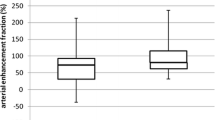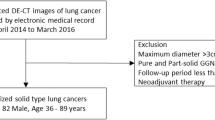Abstract
Objectives
To investigate the relationship of dual-phase dual-energy CT (DE-CT) and tumour size in the evaluation of the response to anti-EGFR therapy in patients with advanced non-small cell lung cancer (NSCLC).
Methods
Dual-phase DE-CT was performed in 31 patients with NSCLC before the onset of anti-EGFR (erlotinib) therapy and as follow-up (mean 8 weeks). Iodine uptake (IU; mg/mL) was quantified using prototype software in arterial and venous phases; arterial enhancement fraction (AEF) was calculated. The change of IU before and after therapy onset was compared with anatomical evaluation in maximal transverse diameter and volume (responders vs. non-responders).
Results
A significant decrease of IU in venous phase was proved in responders according to all anatomical parameters (p=0.002–0.016). In groups of non-responders, a significant change of IU was not proved with variable trends of development. The most significant change was observed using the anatomical parameter of volume (cut-off 73 %). A significant difference of percentage change in AEF was proved between responding and non-responders (p=0.019–0.043).
Conclusion
Dual-phase DE-CT with iodine uptake quantification is a feasible method with potential benefit in advanced assessment of anti-EGFR therapy response. We demonstrated a decrease in vascularization in the responding primary tumours and non-significant variable development of vascularization in non-responding tumours.
Key Points
• Dual-phase DE-CT is feasible for vascularization assessment of NSCLC with anti-EGFR therapy.
• There was a significant decrease of iodine uptake in responding tumours.
• There was a non-significant and variable development in non-responding tumours.
• There was significant difference of AEF percentage change between responders and non-responders.



Similar content being viewed by others
References
Cappuzzo F, Ciuleanu T, Stelmakh L et al (2010) Erlotinib as maintenance treatment in advanced non-small-cell lung cancer: a multicentre, randomised, placebo-controlled phase 3 study. Lancet Oncol 11:521–529
Al-Farsi A, Ellis PM (2014) Treatment paradigms for patients with metastatic non-small cell lung cancer, squamous lung cancer: first, second, and third-line. Front Oncol 27:157
Shepherd FA, Rodrigues Pereira J, Ciuleanu T et al (2005) Erlotinib in previously treated non-small-cell lung cancer. N Engl J Med 353:123–132
Genestreti G, Grossi F, Genova C et al (2014) Third- and further-line therapy in advanced non-small-cell lung cancer patients: an overview. Future Oncol 10:2081–2096
Eisenhauer EA, Therasse P, Bogaerts J et al (2009) New response evaluation criteria in solid tumours: revised RECIST guideline (version 1.1). Eur J Cancer 45:228–247
Nishino M, Hatabu H, Johnson BE, McLoud TC (2014) State of the art: Response assessment in lung cancer in the era of genomic medicine. Radiology 271:6–27
Miles KA, Lee TY, Goh V et al (2012) Current status and guidelines for the assessment of tumour vascular support with dynamic contrast-enhanced computed tomography. Eur Radiol 22:1430–1441
Brix G, Griebel J, Kiessling F, Wenz F (2010) Tracer kinetic modelling of tumour angiogenesis based on dynamic contrast-enhanced CT and MRI measurements. Eur J Nucl Med Mol Imaging 37:S30–S51
Johnson TR, Krauss B, Sedlmair M et al (2007) Material differentiation by dual energy CT: initial experience. Eur Radiol 17:1510–1517
Zhang LJ, Zang GF, Wu SY, Xu J, Lu GM, Schoepf UJ (2013) Dual-energy CT imaging of thoracic malignancies. Cancer Imaging 13:81–91
Joo I, Lee JM, Kim KW, Klotz E, Han JK, Choi BI (2011) Liver metastases on quantitative color mapping of the arterial enhancement fraction from multiphasic CT scans: evaluation of the hemodynamic features and correlation with the chemotherapy response. Eur J Radiol 80:e278–e283
Tiseo M, Ippolito M, Scarlattei M et al (2014) Predictive and prognostic value of early response assessment using 18FDG-PET in advanced non-small cell lung cancer patients treated with erlotinib. Cancer Chemother Pharmacol 73:299–307
Tacelli N, Santangelo T, Scherpereel A et al (2013) Perfusion CT allows prediction of therapy response in non-small cell lung cancer treated with conventional and anti-angiogenic chemotherapy. Eur Radiol 23:2127–2136
van Elmpt W, Zegers CM, Das M, De Ruysscher D (2014) Imaging techniques for tumour delineation and heterogeneity quantification of lung cancer: overview of current possibilities. J Thorac Dis 6:319–327
Sauter AW, Winterstein S, Spira D et al (2012) Multifunctional profiling of non-small cell lung cancer using 18F-FDG PET/CT and volume perfusion CT. J Nucl Med 53:521–529
van Elmpt W, Das M, Hüllner M et al (2013) Characterization of tumor heterogeneity using dynamic contrast enhanced CT and FDG-PET in non-small cell lung cancer. Radiother Oncol 109:65–70
Goh V, Ng QS, Miles K (2012) Computed tomography perfusion imaging for therapeutic assessment: has it come of age as a biomarker in oncology? Invest Radiol 47:2–4
Shim SS, Lee KS, Kim BT et al (2005) Non-small cell lung cancer: prospective comparison of integrated FDG PET/CT and CT alone for preoperative staging. Radiology 236:1011–1019
Kim YN, Lee HY, Lee KS et al (2012) Dual-energy CT in patients treated with anti-angiogenic agents for non-small cell lung cancer: new method of monitoring tumor response? Korean J Radiol 13:702–710
Simons D, Kachelriess M, Schlemmer HP (2014) Recent developments of dual-energy CT in oncology. Eur Radiol 24:930–939
Toepker M, Moritz T, Krauss B et al (2012) Virtual non-contrast in second-generation, dual-energy computed tomography: reliability of attenuation values. Eur J Radiol 81:398–405
Uhrig M, Simons D, Ganten MK, Hassel JC, Schlemmer HP (2015) Histogram analysis of iodine maps from dual energy computed tomography for monitoring targeted therapy of melanoma patients. Future Oncol 11:591–606
Knobloch G, Jost G, Huppertz A, Hamm B, Pietsch H (2014) Dual-energy computed tomography for the assessment of early treatment effects of regorafenib in a preclinical tumor model: comparison with dynamic contrast-enhanced CT and conventional contrast-enhanced single-energy CT. Eur Radiol 24:1896–1905
Baxa J, Vondráková A, Matoušková T et al (2014) Dual-phase dual-energy CT in patients with lung cancer: assessment of the additional value of iodine quantification in lymph node therapy response. Eur Radiol 24:1981–1988
Tawfik AM, Razek AA, Kerl JM, Nour-Eldin NE, Bauer R, Vogl TJ (2014) Comparison of dual-energy CT-derived iodine content and iodine overlay of normal, inflammatory and metastatic squamous cell carcinoma cervical lymph nodes. Eur Radiol 24:574–580
Lind JS, Meijerink MR, Dingemans AM et al (2010) Dynamic contrast-enhanced CT in patients treated with sorafenib and erlotinib for non-small cell lung cancer: a new method of monitoring treatment? Eur Radiol 20:2890–2898
Ng QS, Goh V, Fichte H et al (2006) Lung Cancer perfusion at multi-detector row CT:reproducibility of whole tumor quantitative measurements. Radiology 239:547–553
Kim KW, Lee JM, Klotz E et al (2009) Quantitative CT colour mapping of the arterial enhancement fraction of the liver to detect hepatocellular carcinoma. Radiology 250:425–434
Schmid-Bindert G, Henzler T, Chu TQ et al (2012) Functional imaging of lung cancer using dual energy CT: how does iodine related attenuation correlate with standardized uptake value of 18FDG-PET-CT? Eur Radiol 22:93–103
Werner-Wasik M, Xiao Y, Pequinot E, Curran WJ, Hauck W (2001) Assessment of lung cancer response after nonoperative therapy: tumor diameter, bidimensional product, and volume. A serial CT scan-based study. Int J Radiat Oncol Biol Phys 51:56–61
Acknowledgments
The scientific guarantor of this publication is univ. prof. Jiří Ferda, Ph.D. The authors of this manuscript declare relationships with the following companies: T. Flohr, B. Schmidt and M.Sedlmair are employees of Siemens HealthCare, Germany. This research was supported by the Charles University Research Fund (project number P36) and by the Ministry of Health, Czech Republic – the project of conceptual development of research organization (Faculty Hospital in Pilsen – FNPl, 00669806). One of the authors has significant statistical expertise. No complex statistical methods were necessary for this paper. Institutional Review Board approval was obtained. Written informed consent was obtained from all subjects (patients) in this study. No subjects or cohorts have been previously reported. Methodology: prospective, diagnostic and prognostic, performed at one institution.
Author information
Authors and Affiliations
Corresponding author
Rights and permissions
About this article
Cite this article
Baxa, J., Matouskova, T., Krakorova, G. et al. Dual-Phase Dual-Energy CT in Patients Treated with Erlotinib for Advanced Non-Small Cell Lung Cancer: Possible Benefits of Iodine Quantification in Response Assessment. Eur Radiol 26, 2828–2836 (2016). https://doi.org/10.1007/s00330-015-4092-6
Received:
Revised:
Accepted:
Published:
Issue Date:
DOI: https://doi.org/10.1007/s00330-015-4092-6




